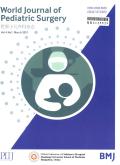Understanding pediatric surgical needs in North Korea: a modeling analysis
IF 0.8
4区 医学
Q4 PEDIATRICS
引用次数: 0
Abstract
Background Sixty-five percent of children worldwide lack access to surgical care, the majority of whom live in low-income and middle-income countries (LMICs). Developing surgical infrastructure requires information on surgical need; however, this information is often limited in LMICs. North Korea (Democratic People’s Republic of Korea, DPRK) has a low amount of publicly available data. Here, we analyzed available modeled data to understand the causes of pediatric deaths due to conditions treatable with surgery in DPRK. Methods We used World Bank data and models from the Institute for Health Metrics and Evaluation to identify causes of pediatric deaths affecting pediatric patients (age <20 years). We compared mortality of disease between DPRK and countries with similar economic status. Results Between 1990 and 2019, the number of overall pediatric deaths has decreased. In 2019, 32.2% of all pediatric deaths in DPRK were caused by surgical conditions. The leading categories of surgical conditions were injuries (53.9%), congenital conditions (34.2%), tumors (8.8%), and abdominal conditions (3.2%). DPRK has a lower relative rate of pediatric deaths compared with other LMICs with similar gross domestic product per capita. However, it has a higher relative rate of pediatric deaths due to conditions requiring treatment with surgery. Transport injuries contribute significantly to the high rate of pediatric deaths in DPRK. Conclusions Although DPRK may be allocating overall resources toward pediatric healthcare more efficiently than economic peers, DPRK may benefit from improvement in pediatric surgical capacity. Improved availability of data and close international collaboration could be potential solutions to bridge this gap. Data are available in a public, open access repository.了解北朝鲜的儿科手术需求:模型分析
背景 全世界 65% 的儿童得不到外科治疗,其中大多数生活在中低收入国家(LMICs)。发展外科基础设施需要获得有关外科需求的信息;然而,这些信息在低收入和中等收入国家往往十分有限。朝鲜(Democratic People's Republic of Korea, DPRK)的公开数据较少。在此,我们对现有的模型数据进行了分析,以了解朝鲜儿童因可通过手术治疗的疾病而死亡的原因。方法 我们利用世界银行的数据和卫生计量与评估研究所的模型,找出影响儿科患者(年龄小于 20 岁)的儿科死亡原因。我们比较了朝鲜与经济状况相似的国家之间的疾病死亡率。结果 从1990年到2019年,儿科总死亡人数有所下降。2019 年,朝鲜所有儿科死亡病例中有 32.2% 是由外科疾病造成的。外科疾病的主要类别是外伤(53.9%)、先天性疾病(34.2%)、肿瘤(8.8%)和腹部疾病(3.2%)。与人均国内生产总值相近的其他低收入国家相比,朝鲜的儿科相对死亡率较低。然而,朝鲜因需要手术治疗的疾病而导致的儿科死亡相对较高。运输伤害是造成朝鲜儿科高死亡率的重要原因。结论 虽然朝鲜在儿科医疗保健方面的总体资源分配效率可能高于经济水平较低的国家,但朝鲜仍可受益于儿科手术能力的提高。改善数据的可用性和密切的国际合作可能是缩小这一差距的潜在解决方案。数据可在公开、开放的资料库中获取。
本文章由计算机程序翻译,如有差异,请以英文原文为准。
求助全文
约1分钟内获得全文
求助全文

 求助内容:
求助内容: 应助结果提醒方式:
应助结果提醒方式:


